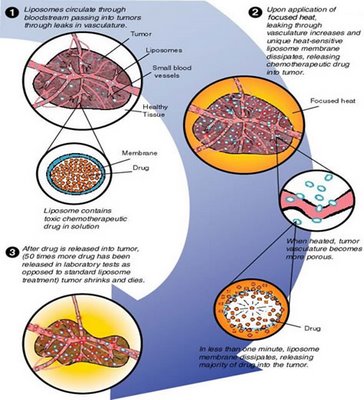Liposomes Become Heat Seeking Missiles--Blast Tumours with Doxorubicin
 By combining the heating of tumours with a heat-sensitive liposome/doxorubicin package [Thermodox], Duke University researchers have achieved impressive results treating human tumours transplanted first into mice and then rats. Phase I clinical studies are ongoing at Duke University Medical Center.
By combining the heating of tumours with a heat-sensitive liposome/doxorubicin package [Thermodox], Duke University researchers have achieved impressive results treating human tumours transplanted first into mice and then rats. Phase I clinical studies are ongoing at Duke University Medical Center.In the study the scientists found that during the heat activated liposome administration the time at which the heat was applied could be used to control the amount of drug delivered to different areas of a tumor and its anti-tumor efficacy. Doxorubicin accumulated more quickly and reached higher concentrations in the tumor when the heat was applied simultaneously with the drug administration when compared to application of heat prior to the infusion. Simultaneous administration also produced the greatest anti-tumor effect. Heat applied before and during the heat activated liposome infusion produced a uniform distribution of doxorubicin within the tumor, whereas doxorubicin was only found in the periphery of the tumor when heat was applied during the liposome administration. Since the periphery also contains the blood vessels supplying the tumor, the greatest anti-tumor activity produced by the simultaneous administration of heat and heat activated liposome is probably due to the effect of doxorubicin on the tumor blood vessels.Source.
Lysolipid-containing temperature sensitive liposomes were invented by Dr. David Needham, Professor, Mechanical Engineering and Material Sciences at Duke University. Celsion has licensed global rights to the technology and is currently using a heat activated liposome containing doxorubicin (ThermoDox(TM)) in Phase I clinical studies in liver cancer and recurrent chest wall breast cancer, the latter study being performed at Duke University where Dr. Kim Blackwell is the principal investigator. Celsion is working with the FDA to finalize endpoints for a Phase III study in primary liver cancer and expects to initiate enrollment in this study in 2007.
The study in Journal of National Cancer Institute, Jan 3 2007 edition, reports very good results in the rapid killing of tumour cells with this technique. It is known that some tumours are sensitive to heat, so combining focused heat on tumours with heat-sensitive liposomes filled with Doxorubicin, seems to be a highly synergistic approach.
This approach is clever and likely to be of benefit to many cancer sufferers. It is important to achieve even more precise targeting than this, however, and to move to drugs that are as effectively toxic to tumour cells, but less toxic to normal cells.
Because of the relationship between stem cells and cancer, it may be impossible to prevent all cancers. Early detection combined with precise targeting and highly selective toxicity may be the best we can do for now.

0 Comments:
Post a Comment
“During times of universal deceit, telling the truth becomes a revolutionary act” _George Orwell
<< Home